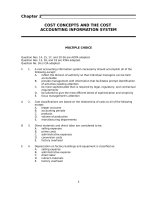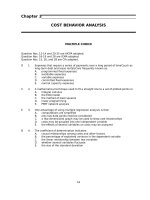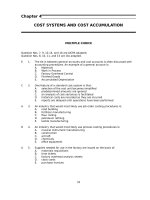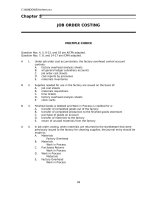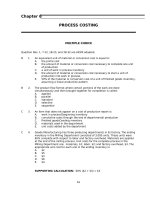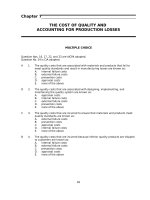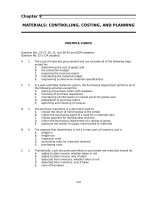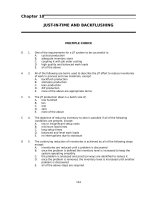Test bank cost accounting 6e by usry 22 planning for capital expenditures
Bạn đang xem bản rút gọn của tài liệu. Xem và tải ngay bản đầy đủ của tài liệu tại đây (59.16 KB, 13 trang )
Chapter 22
PLANNING FOR CAPITAL EXPENDITURES
MULTIPLE CHOICE
Question No. 4 is AICPA adapted.
Question No. 3 is ICMA adapted.
Question No. 2 is CIA adapted.
D
1.
The type of costs presented to management for a decision to replace equipment should be
limited to:
A.
controllable costs
B.
conversion costs
C.
historical costs
D.
relevant costs
E.
standard costs
B
2.
A company can replace the machinery currently used to manufacture its product with more
efficient machinery. The new machinery will reduce labor and also will reduce the percentage
of spoiled units. It is expected to have a useful life of 5 years. The most appropriate technique
for determining whether or not the company should replace its machinery with the new, more
efficient machinery is:
A.
cost-volume-profit analysis
B.
capital-budgeting analysis
C.
regression analysis
D.
linear programming
E.
none of the above
D
3.
Depreciation is incorporated explicitly in the cash flow analysis of an investment proposal
because it:
A.
is a cost of operations that cannot be avoided
B.
results in an annual cash outflow
C.
is a cash inflow
D.
reduces the cash outlay for income taxes
E.
represents the initial cash outflow spread over the life of the investment
E
4.
Common problems related to ethical considerations in the capital budgeting include all of the
following, except:
A.
superiors and associates sometimes apply pressure to circumvent the approval process
B.
pressure may exist to write-off or devalue assets below their true value to justify
replacement
C.
the economic benefit of capital projects may be exaggerated to increase the likelihood of
approval
D.
the accountant may mistakenly go to the individuals involved in the ethical conflict
first, rather than first discussing it with the accounting supervisor
E.
all of the above are ethical problems related to capital budgeting
75
76
D
Chapter 22
5.
Maxwell Company has an opportunity to acquire a new machine to replace one of its present
machines. The new machine would cost $90,000, have a 5-year life, and no estimated salvage
value. Variable operating costs would be $100,000 per year. The present machine has a book
value of $50,000 and a remaining life of 5 years. Its disposal value now is $5,000, but it would
be zero after 5 years. Variable operating costs would be $125,000 per year. Ignore income
taxes. Considering the 5 years in total, what would be the difference in profit before income
taxes by acquiring the new machine as opposed to retaining the present one?
A.
$10,000 decrease
B.
$15,000 decrease
C.
$35,000 increase
D.
$40,000 increase
E.
none of the above
SUPPORTING CALCULATION:
Additional depreciation on the new machine..............................................................
Loss on sale of old machine.............................................................................................
Operating cost savings.....................................................................................................
Increase in income.............................................................................................................
$ (40,000)
(45,000)
125,000
$ 40,000
D
6.
Effective planning and control is important for the effective administration of a capital
expenditure program because:
A.
the long-term commitment increases financial risk
B.
the magnitude of expenditures is substantial and the economic penalties for unwise
decisions are usually severe
C.
decisions made in this area provide the structure for operation of the firm
D.
all of the above
E.
none of the above
D
7.
A company manual used for detailing policies and procedures required for administering the
capital expenditure program should:
A.
encourage people to work on and submit new ideas
B.
focus attention on useful analytical tasks
C.
facilitate rapid project development and expeditious review
D.
all of the above
E.
none of the above
D
8.
A number of evaluations of a single capital expenditure proposal may be necessary because of:
A.
circumstances that change during the time span from the origin of the project idea to its
completion
B.
alternative solutions of the problem for which the project is designed
C.
assumptions that vary as to the amount and timing of cash flows
D.
all of the above
E.
none of the above
Planning for Capital Expenditures
77
A
9.
The following capital expenditures that compare the future costs of the old assets with the
future costs of the new assets as a basis for making a decision are:
A.
replacement expenditures
B.
expansion expenditures
C.
improvement expenditures
D.
allowance expenditures
E.
none of the above
B
10.
In which of the following types of capital expenditure decisions does the basis for a decision
most markedly shift from cost savings to increased profits and cash flow?
A.
replacement expenditures
B.
expansion expenditures
C.
improvement expenditures
D.
allowance expenditures
E.
none of the above
C
11.
The capital expenditures in which the benefits are most difficult to quantify are:
A.
replacement expenditures
B.
expansion expenditures
C.
improvement expenditures
D.
allowance expenditures
E.
none of the above
C
12.
Primary motivations for computer integrated manufacturing, robotics, and flexible
manufacturing systems include all of the following, except:
A.
the need to improve product quality in the face of increasing competition
B.
the desire to be able to adjust production output quantity quickly to satisfy changing
consumer demand
C.
cost savings
D.
the desire to be able to adjust production output variety quickly to satisfy changing
consumer demand
E.
all of the above are primary motivations
B
13.
All of the following are common cash inflows related to capital expenditure proposals, except:
A.
additional revenues from increased sales
B.
increased working capital requirements
C.
reduction in inventory carrying costs
D.
salvage value at the end of the project
E.
all of the above are cash inflows
E
14.
All of the following are common cash outflows from capital expenditure programs, except:
A.
equipment installation
B.
employee training
C.
computer programming and fine tuning
D.
increased working capital requirements
E.
salvage value at the end of the project
78
Chapter 22
C
15.
The system for recovering the cost of capital expenditures through federal income tax
deductions that was required for tangible, depreciable property placed in service after 1980 is
known as:
A.
MACRS
B.
200% declining balance
C.
ACRS
D.
150% declining balance
E.
none of the above
A
16.
Under the Tax Reform Act of 1986, the system that increased the number of property classes
and lengthened the recovery periods of most kinds of depreciable property is known as:
A.
MACRS
B.
200% declining balance
C.
ACRS
D.
150% declining balance
E.
none of the above
D
17.
An example of 5-year property under MACRS is:
A.
most manufacturing machinery
B.
railroad cars
C.
commercial aircraft
D.
light trucks
E.
none of the above
B
18.
An example of 7-year property under MACRS is:
A.
automobiles
B.
most manufacturing machinery
C.
light trucks
D.
small aircraft
E.
none of the above
A
19.
An example of 27.5-year property under MACRS is:
A.
residential rental property
B.
commercial aircraft
C.
nonresidential buildings
D.
railroad cars
E.
none of the above
C
20.
Under MACRS, the depreciation on tangible personal property is computed as if the property
were placed into service at the:
A.
beginning of the year
B.
end of the year
C.
midpoint of the year
D.
midpoint of the month
E.
none of the above
D
21.
Under MACRS, the depreciation on real property is computed as if the property were placed
into service at the:
A.
beginning of the year
B.
end of the year
C.
midpoint of the year
D.
midpoint of the month
E.
none of the above
Planning for Capital Expenditures
D
22.
79
A machine that cost $50,000 and is fully depreciated is sold for $10,000. The $10,000 is then
used as a down payment on the purchase of a new machine costing $75,000. Assuming a 40%
tax rate, the out-of-pocket cost of the new machine is:
A.
$75,000
B.
$71,000
C.
$65,000
D.
$69,000
E.
none of the above
SUPPORTING CALCULATION:
Cost of new machine.............................................................................................................
Less: After-tax inflow from old machine ($10,000 x .60).............................................
.......................................................................................................................................
C
23.
$75,000
6,000
$69,000
A machine that cost $50,000 and is fully depreciated is allowed as a $10,000 trade-in on a
machine costing $75,000. Assuming a 40% tax rate, the out-of-pocket cost of the new
machine is:
A.
$75,000
B.
$71,000
C.
$65,000
D.
$69,000
E.
none of the above
SUPPORTING CALCULATION:
Cost of new machine.............................................................................................................
Less: Trade-in allowance.....................................................................................................
.......................................................................................................................................
$75,000
10,000
$65,000
80
Chapter 22
PROBLEMS
PROBLEM
1.
Estimating Pretax Cash Inflows. Skyway Corporation is considering purchasing a new machine to be used
to manufacture a new product, called Jax, which will sell for $15 a unit. Variable manufacturing cost is
expected to be $5 for each unit of Jax manufactured, and variable marketing cost, $2 for each unit sold.
The machine being considered could produce 10,000 units a year, all of which the Marketing Department
believes could be sold for $15 a unit. The proposed machine would cost $250,000. Although the machine
would probably last 8 years, management believes that the product's life cycle would be only 5 years. The
salvage value of the new machine at the end of the product's 5-year life cycle is expected to be $50,000.
Management does not believe the machine could be used to manufacture any of the company's other
products.
Required: Compute the pretax net cash inflows expected from the capital expenditure proposal for each
year, and ignoring the effect of income taxes, determine the excess of cash inflows from all sources over the
cost of the machine.
SOLUTION
Year
1
2
3
4
5
Estimated
Demand
in Units
10,000
10,000
10,000
10,000
10,000
Unit Sales
Price
$15
15
15
15
15
Unit
Variable
Cost
$7
7
7
7
7
Unit
Contribution
Margin
$8
8
8
8
8
Total net pretax cash inflows from sales......................................................
Initial cash outflow (cost of asset)................................................................
Less pretax estimated salvage value.............................................................
Excess of net pretax cash inflows over cost.................................................
Net Pretax
Cash Inflows
From Sales
$ 80,000
80,000
80,000
80,000
80,000
$ 400,000
$
250,000
(50,000)
200,000
$ 200,000
Planning for Capital Expenditures
81
PROBLEM
2.
Estimating Pretax Cash Inflows With Inflation. Speedi Corporation is considering a capital expenditure
proposal which will require an initial cash outlay of $50,000. The project life is expected to be 6 years. The
estimated salvage value for the equipment (based on today's market price for similar used 6-year old
equipment) is $2,500. Estimated annual net cash inflows from operations during the life of the project
follow:
Year
1
2
3
4
5
6
Estimated Annual
Cash Inflow
$10,000
15,000
15,000
15,000
10,000
5,000
Required: Compute the excess of cash inflows over cash outflows assuming management expects a constant
4% rate of inflation during the 6-year period. (Round your price level index to three decimal places.)
SOLUTION
Year
1
2
3
4
5
6
Estimated Net
Pretax Cash
Inflows
$10,000
15,000
15,000
15,000
10,000
5,000
4% Annual
Price-level
Adjustment
(1 + .04) 1 = 1.040
(1 + .04) 2 = 1.082
(1 + .04) 3 = 1.125
(1 + .04) 4 = 1.170
(1 + .04) 5 = 1.217
(1 + .04) 6 = 1.265
Price-level
Adjusted Net
Cash Inflows
$ 10,400
16,230
16,875
17,550
12,170
6,325
Total price-level adjusted net pretax cash inflows
from operations.......................................................................................................
$ 79,550
Plus cash inflow from salvage.......................................................................................
$2,500
Price-level adjustment....................................................................................................
1.265
3,163
Total price-level adjusted net pretax cash inflows
over initial cash outflow........................................................................................
$ 82,713
Less initial cash outflow.................................................................................................
50,000
Excess of net pretax cash inflows over initial cash outflow ....................................
$ 32,713
82
Chapter 22
PROBLEM
3.
Estimating After-tax Cash Flows for CIM Project. Athens Corporation is considering the various benefits
that may result from the shortening of its production cycle by changing from the company's present
manufacturing system to a computer integrated manufacturing (CIM) system. The proposed system can
provide productive time equivalency close to the 25,000 hours available annually with the company's
present system. The present system costs $50 per hour more to operate than the proposed CIM system.
The company expects to operate the system at full capacity. The annual out-of-pocket costs of maintaining
the proposed CIM system is $500,000 more than the company's present system. The proposed CIM system
will require an initial investment of $1,000,000. The system is expected to have a useful life of 6 years with
no expected salvage value. The company is in a 40% tax-rate bracket.
Required: Compute the relevant annual after-tax cash flows expected from the CIM project. (Assume the
equipment is 5-year class MACRS property and use the rates provided below.)
(AICPA adapted)
Year
1
2
3
4
5
6
MACRS 5-year
Recovery Rate
0.200
0.320
0.192
0.115
0.115
0.058
1.000
Planning for Capital Expenditures
83
SOLUTION
Year
1
2
3
4
5
6
(1)
Annual
Operating
Savings With
CIM*
$1,250,000
1,250,000
1,250,000
1,250,000
1,250,000
1,250,000
(2)
(3)
Additional
Maintenance
Cost With CIM
$500,000
500,000
500,000
500,000
500,000
500,000
Tax
Depreciation**
$200,000
320,000
192,000
115,000
115,000
58,000
(
(
(
(
(
(
(
(
(
(
(
(5)
Tax Liability
With 40%
Tax Rate
40% x (4)
$220,000
172,000
223,200
254,000
254,000
276,800
(4)
)
)
Taxable
)
Income (Loss) )
(1)-(2)-(3)
)
$550,000 )
430,000 )
558,000 )
635,000 )
635,000 )
692,000 )
(6)
Net After-tax
Cash Inflows
(1)-(2)-(5)
$530,000
578,000
526,800
496,000
496,000
473,200
Total net after-tax cash inflows....................................................................................................... $
3,100,000
Less initial cash outflow to purchase system................................................................................
1,000,000
Excess of net after-tax cash inflows over initial cash outflow ................................................... $
2,100,000
*Annual hours of operating capacity.............................................................................................
Savings per hour with CIM.............................................................................................................. x
$
**
Year
1
2
3
4
5
6
MACRS 5-year
Recovery Rate
0.200
0.320
0.192
0.115
0.115
0.058
1.000
Depreciable Basis
$1,000,000
1,000,000
1,000,000
1,000,000
1,000,000
1,000,000
Tax
Depreciation
$
200,000
320,000
192,000
115,000
115,000
58,000
$ 1,000,000
25,000
$50
1,250,000
84
Chapter 22
PROBLEM
4.
Computing After-tax Cash Inflows. Stevie Company is considering a capital expenditure with the
following estimated net cash inflows:
Year
1
2
3
4
5
6
Estimated Pretax Inflation
Adjusted Net Cash Inflow
$ 70,000
80,000
90,000
110,000
100,000
80,000
The equipment required for the project would have an initial cost of $500,000, and it is not expected to
have any salvage value at the end of the life of the project. The equipment will be depreciated using the
straight-line method over its economic life of 6 years for book purposes; however, it qualifies as 5-year
property for tax purposes. The company's effective tax rate is 40%.
Required: Determine the estimated after-tax net cash inflows for each of the project's 6 years, and the total
excess of cash inflows over the life of the project over cash outflows. (Use the MACRS rates provided
below to compute tax depreciation.)
Year
1
2
3
4
5
6
MACRS 5-year
Recovery Rate
0.200
0.320
0.192
0.115
0.115
0.058
1.000
Planning for Capital Expenditures
85
SOLUTION
(1)
Year
1
2
3
4
5
6
(2)
Estimated
Inflation
Adjusted Net
Cash Inflows
$ 70,000
80,000
90,000
110,000
100,000
80,000
Tax
Depreciation*
$100,000
160,000
96,000
57,500
57,500
29,000
(3)
Taxable
Income
(Loss)
(1) - (2)
$(30,000 )
(80,000 )
(6,000 )
52,500
42,500
51,000
(4)
Tax Liability
With 40%
Tax Rate
40% x (3)
$(12,000 )
(32,000 )
(2,400 )
21,000
17,000
20,400
Total net after-tax cash inflows.......................................................................................................
(5)
Net
After-tax
Cash
Inflows
(1) - (4)
$
82,000
112,000
92,400
89,000
83,000
59,600
$
Less initial cash outflow to purchase system................................................................................
Excess of net after-tax cash inflows over initial cash outflow ...................................................
*
Year
1
2
3
4
5
6
MACRS
5-year
Recovery
Rate
0.200
0.320
0.192
0.115
0.115
0.058
1.000
Depreciable
Basis
$500,000
500,000
500,000
500,000
500,000
500,000
518,000
500,000
$
18,000
Tax
Depreciation
$100,000
160,000
96,000
57,500
57,500
29,000
$500,000
PROBLEM
5.
Effect of Inflation and Taxes on Investment Decision. Weighout Company is evaluating a capital
expenditure proposal that will require an initial cash investment of $100,000. The project will have a 6year life; however, the property will qualify as 5-year property for income-tax depreciation purposes. The
income tax rate is 40%. The annual cash inflows from the project, before any adjustment for the effects of
inflation or income taxes, are expected to be as follows:
Year
1
2
3
4
5
6
Unadjusted
Estimate of
Cash Inflows
$25,000
27,000
29,000
23,000
20,000
15,000
86
Chapter 22
The expected salvage value of the property is zero. Cash inflows are expected to increase at the anticipated
inflation rate of 4% each year.
Required: Compute the inflation adjusted after-tax cash inflow from the proposal for each year, and the
excess of total net cash inflows over the initial cash outlay. (Use the MACRS depreciation rates provided
below to compute tax depreciation, and round the price-level index to three decimal places.)
MACRS 5-year
Recovery Rate
0.200
0.320
0.192
0.115
0.115
0.058
1.000
Year
1
2
3
4
5
6
SOLUTION
(1)
Year
1
2
3
4
5
6
Periodic
Cash
Inflows
$ 25,000
27,000
29,000
23,000
20,000
15,000
$ 139,000
(1)
Year
1
2
3
4
5
6
Depreciable
Basis of
Property
$100,000
100,000
100,000
100,000
100,000
100,000
(2)
4% Price-level Adjustment
(1 + .04) 1 = 1.040
(1 + .04) 2 = 1.082
(1 + .04) 3 = 1.125
(1 + .04) 4 = 1.170
(1 + .04) 5 = 1.217
(1 + .04) 6 = 1.265
(2)
5-Year
Property
Recovery
Percentage
0.200
0.320
0.192
0.115
0.115
0.058
(3)
Inflation
Adjusted
Estimate of
Cash
Inflows
(1) x (2)
$ 26,000
29,214
32,625
26,910
24,340
18,975
$ 158,064
(3)
Tax
Depreciation
(1) x (2)
$ 20,000
32,000
19,200
11,500
11,500
5,800
$ 100,000
Planning for Capital Expenditures
Year
1
2
3
4
5
6
(1)
Adjusted
Estimate of
Net Cash
Inflows
$26,000
29,214
32,625
26,910
24,340
18,975
87
(2)
(3)
Taxable
Income
(Loss)
(1) - (2)
$ 6,000
(2,786)
13,425
15,410
12,840
13,175
Tax
Depreciation
$20,000
32,000
19,200
11,500
11,500
5,800
(
(
(
(
(
(
(
(
(
(
(
(
(5)
Income Tax
(3) x (4)
$ 2,400
(1,114)
5,370
6,164
5,136
5,270
(4)
Federal and
State
Income Tax
Rate
40%
40%
40%
40%
40%
40%
(6)
Net
After-tax
Cash
Inflows
(1) - (5)
$23,600
30,328
27,255
20,746
19,204
13,705
Total estimated net after-tax cash inflows from project...............................................................
$134,838
Less initial cash outflow for machinery...........................................................................................
100,000
Excess of after-tax cash inflows from project over initial cash outflow ....................................
$ 34,838
)
)
)
)
)
)
)
)
)
)
)

